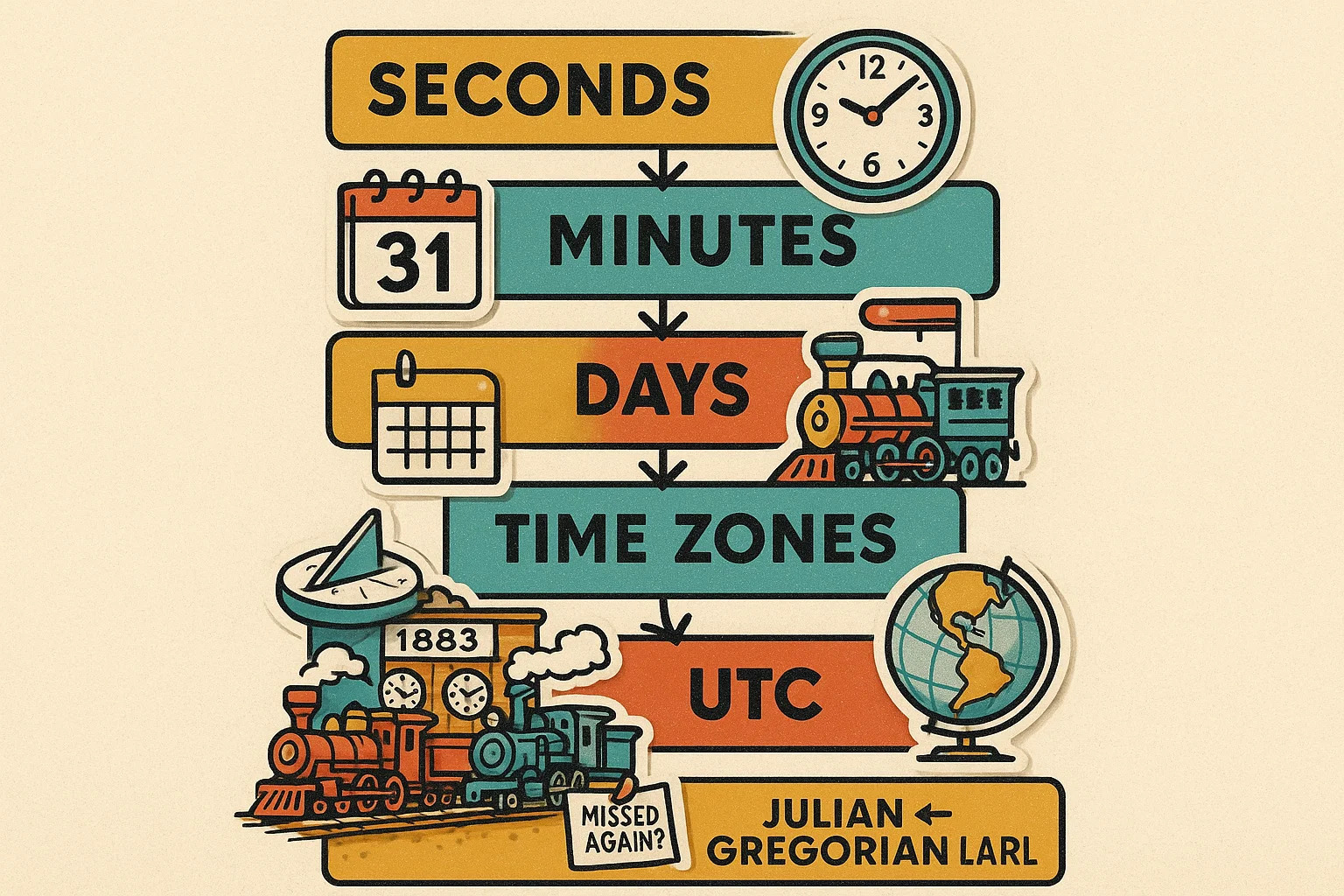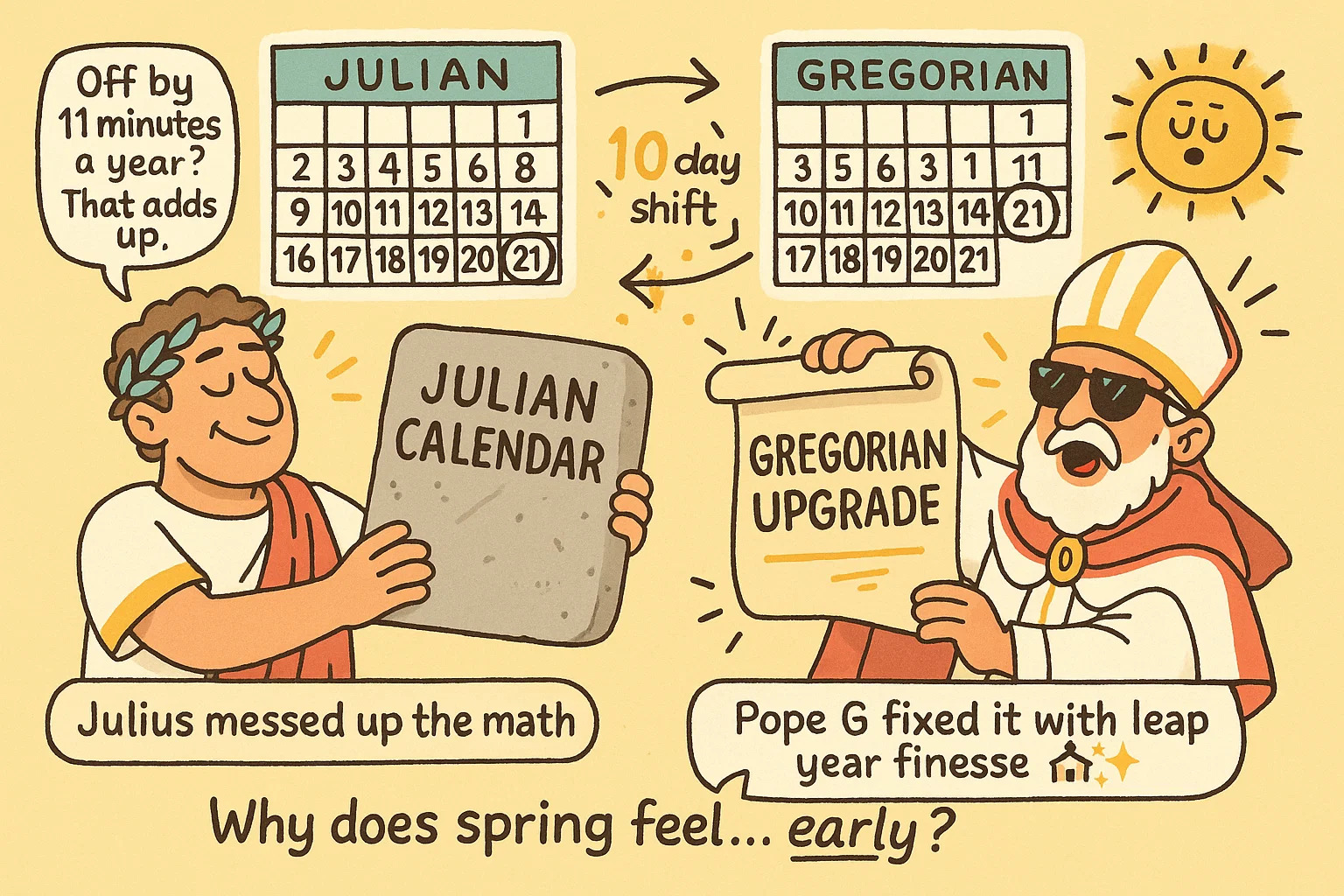Ever tried to schedule a call across countries, figure out how many milliseconds are in a day, or understand why some years have an extra day? Time might seem simple — 60 minutes in an hour, 24 hours in a day — but it quickly gets complicated when you factor in time zones, leap years, and even leap seconds. A time converter helps cut through the confusion by making it easy to switch between seconds, days, months, and global time systems without the mental math.
What Is Time Conversion?
Time conversion is the process of switching between different units or systems of time — from the basics like seconds, minutes, and hours to more complex calculations like adjusting for time zones, leap years, or even converting historical dates across calendars. It’s something most people do daily, even without realizing it: setting a meeting across continents, converting work hours into pay, or calculating travel times.
What makes time conversion tricky is that not all time systems are created equal. Standard clock time (what we use every day) follows a 24-hour cycle, but scientists and navigators often work with Coordinated Universal Time (UTC), which is based on atomic clocks and adjusted with leap seconds to stay aligned with Earth’s rotation¹. Meanwhile, historians and astronomers may use Julian dates or convert between the Gregorian and Julian calendars, which can shift dates by several days for events before the 20th century².
For most people, time conversion helps with everyday tasks like:
-
Converting hours to minutes or days when tracking schedules.
-
Adjusting between time zones when traveling or working remotely.
-
Converting historical or astronomical times into today’s standard format for research.
Fun Fact: “In 1883, American railroads adopted standardized time zones to solve scheduling chaos — before that, each city kept its own local time based on the sun, causing thousands of missed trains every year.”³

Common Time Units and Their Conversions
Time can be measured in everything from vast spans of years to unimaginably small fractions of a second. For most daily uses, we deal with seconds, minutes, and hours — but in science, computing, and engineering, far smaller or larger units are essential. Here’s how these units relate to one another:
-
Second – The base unit of time in the International System (SI). Almost all time conversions start here.
-
Millisecond (ms) – One thousandth of a second (1 second = 1,000 milliseconds).
-
Microsecond (µs) – One millionth of a second (1 second = 1,000,000 microseconds).
-
Nanosecond (ns) – One billionth of a second (1 second = 1,000,000,000 nanoseconds). Often used in computing and telecommunications.
-
Picosecond (ps) – One trillionth of a second (1 second = 1,000,000,000,000 picoseconds). Critical in high-speed electronics and quantum research.
-
Minute – 60 seconds.
-
Hour – 60 minutes (3,600 seconds).
-
Day – 24 hours (86,400 seconds).
-
Week – 7 days (168 hours, 604,800 seconds).
-
Month – Typically treated as 30 or 31 days for simple calculations, but astronomically based on the lunar cycle (~29.53 days).
-
Year – 12 months, or 365 days (366 in a leap year). Equals 31,536,000 seconds in a common year.
When converting between these units, most people work in simple multiples (60 seconds in a minute, 24 hours in a day). But for highly precise work — like tracking satellites or syncing global computer networks — fractions like nanoseconds and picoseconds matter because even a billionth of a second can affect data accuracy4.
For fast calculations across all these units — from milliseconds to years — our Conversion Tools can save you time on manual math.
Fun Fact: “In 1967, the second was officially redefined by the International System of Units (SI) based on the vibration frequency of a cesium-133 atom — not the Earth’s rotation — because atomic clocks are far more precise.”5
How Calendars and Time Systems Differ
Time isn’t measured the same way everywhere — and it hasn’t been throughout history. The calendar and time system we use today is a product of centuries of refinement, designed to keep human schedules aligned with the movements of the Earth and the Sun.
Gregorian vs. Julian Calendars
Most of the world now follows the Gregorian calendar, introduced by Pope Gregory XIII in 1582 to replace the older Julian calendar. The Julian system miscalculated the length of a year by about 11 minutes, which caused dates for seasonal events, like the spring equinox, to drift over centuries. The Gregorian reform adjusted the leap year rules to keep the calendar in better sync with Earth’s orbit around the Sun⁶.
For events before the 20th century, this shift can mean a difference of 10 to 13 days when converting historical dates.

Leap Years and Leap Seconds
Even the Gregorian calendar isn’t perfect. To account for the fact that a solar year is about 365.2422 days, we add an extra day — February 29th — nearly every four years. However, not every year divisible by 4 is a leap year: years divisible by 100 skip the leap day unless divisible by 400 (like the year 2000)⁷.
On a smaller scale, timekeeping agencies also insert leap seconds to keep Coordinated Universal Time (UTC) in line with the slightly irregular rotation of Earth. Since 1972, leap seconds have been added 27 times, often announced months in advance by the International Earth Rotation and Reference Systems Service (IERS)⁸.
Daylight Saving Time and Time Zone Offsets
Beyond the calendar, time shifts each year because of Daylight Saving Time (DST) and global time zones.
-
DST, used in parts of North America and Europe, moves clocks forward by one hour in spring and back in autumn to extend daylight in the evenings.
-
Time zones themselves are political as much as geographic: China, despite spanning five standard time zones, uses only one official time zone — Beijing Time.
These variations make time conversion more complex than just multiplying hours or days, especially when dealing with historical dates, global events, or scientific observations.
Fun Fact: “The first leap second, added on June 30, 1972, caused unexpected glitches in computer systems, proving that even a single second can disrupt global networks.”⁹
How Time Conversions Are Calculated
Time conversions may sound simple — just multiply or divide by 60 or 24 — but once you factor in different calendars, time zones, and scientific adjustments, things get complicated fast.
Converting Within the 24-Hour Day
Most basic conversions use fixed relationships:
-
60 seconds in a minute, 60 minutes in an hour, 24 hours in a day.
-
To convert hours to minutes, multiply by 60; to convert days to seconds, multiply by 86,400 (24 × 60 × 60).
For longer spans, months and years require approximations because months vary (28–31 days) and years include leap years every four years (with some exceptions)¹⁰.
Adjusting for Time Zones and Daylight Saving
When converting time across locations, you need to apply the offsets for each time zone, which range from UTC-12 (like Baker Island) to UTC+14 (Kiribati’s Line Islands). Some regions also follow Daylight Saving Time, which adds or subtracts an hour during parts of the year¹¹.
For example:
-
If it’s 3:00 PM UTC in London during winter, it’s 10:00 AM Eastern Standard Time (EST) in New York.
-
But during summer, with Daylight Saving in effect, 3:00 PM UTC becomes 11:00 AM Eastern Daylight Time (EDT).
Converting Historical and Astronomical Dates
For researchers, Julian Day Numbers (JDN) are often used to simplify calculations. These count days continuously since January 1, 4713 BCE, and avoid the leap year and month-length issues that plague the Gregorian calendar¹².
-
To convert a date from Julian to Gregorian (or vice versa), you typically calculate the Julian Day Number first, then convert back to the target calendar.
-
Astronomers also use Terrestrial Time (TT), a theoretical time scale that ignores irregularities in Earth’s rotation, for precise orbital calculations¹³.
Because of these complexities, modern time conversion often relies on reference tables or algorithms from agencies like NIST, the U.S. Naval Observatory, and the IERS to ensure accuracy, especially for computing, navigation, and science.
Fact Check: “The difference between UTC (atomic time) and UT1 (Earth rotation time) can drift by more than 0.9 seconds without leap seconds, which is enough to throw off GPS and satellite tracking if not corrected.”¹⁴
Time Zones and Global Coordination
Time zones were created to bring order to a world that was, quite literally, running on thousands of different clocks. Before the late 19th century, most cities kept local time based on the Sun, meaning noon could vary by minutes — or even hours — from one town to the next. The introduction of standardized time zones, largely driven by railroads and global trade, made scheduling possible on a worldwide scale¹⁵.
Coordinated Universal Time (UTC)
Today, almost all timekeeping starts with Coordinated Universal Time (UTC), the official global standard maintained using ultra-precise atomic clocks.
-
UTC does not change for Daylight Saving Time and serves as the reference point for converting to local times.
-
Aviation, shipping, space agencies, and tech industries all rely on UTC to avoid confusion in cross-border operations¹⁶.
For example, flight schedules are typically published in UTC so airlines and airports across continents can coordinate without worrying about seasonal clock changes.
Global Offsets and Unique Cases
Most countries set their local time as an offset from UTC (e.g., UTC-5 for U.S. Eastern Standard Time). However, there are exceptions:
-
India uses UTC+5:30, a half-hour offset.
-
Nepal uses UTC+5:45, one of the few quarter-hour zones.
-
China, despite spanning five geographical time zones, observes a single official time — Beijing Time (UTC+8) for the entire country¹⁷.
These quirks make time conversion essential for anyone coordinating events, trade, or travel across borders.
Fun Fact: “The Line Islands in Kiribati (UTC+14) are the first places on Earth to ring in the New Year, while Baker Island (UTC-12) is one of the last — a 26-hour difference despite being only about 2,000 miles apart.”¹⁸
- National Institute of Standards and Technology (NIST). Time and Frequency Division: Coordinated Universal Time (UTC).
-
U.S. Naval Observatory. Julian and Gregorian Calendar Conversions.
-
Library of Congress. The Day Railroads Standardized Time (History of U.S. Time Zones).
-
National Institute of Standards and Technology (NIST). SI Base Units – The Second (Time).
-
Bureau International des Poids et Mesures (BIPM). Definition of the Second and Its Applications (2023).
-
U.S. Naval Observatory. The Gregorian Calendar Reform (Historical Overview).
-
National Institute of Standards and Technology (NIST). Leap Year Rules and Calendar Adjustments.
-
International Earth Rotation and Reference Systems Service (IERS). Leap Second Bulletins and History.
-
Smithsonian Institution. The Day the Leap Second Confused Computers (Technology History).
-
National Institute of Standards and Technology (NIST). Time Intervals and Calendar Conversions.
-
International Telecommunication Union (ITU). Time Zones and Daylight Saving Adjustments Worldwide.
-
U.S. Naval Observatory. Julian Day Numbers and Astronomical Applications.
-
NASA Jet Propulsion Laboratory. Terrestrial Time and Planetary Ephemerides.
-
International Earth Rotation and Reference Systems Service (IERS). Leap Second and UT1–UTC Corrections.
-
Library of Congress. The Standardization of Time Zones in the 19th Century.
-
International Telecommunication Union (ITU). Role of UTC in Global Communications and Navigation.
-
Time and Date AS. Unusual Time Zones and Half-Hour Offsets.
-
U.S. Naval Observatory. World Time Zone Extremes and International Date Line.

